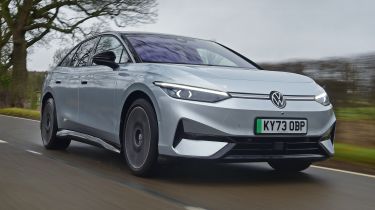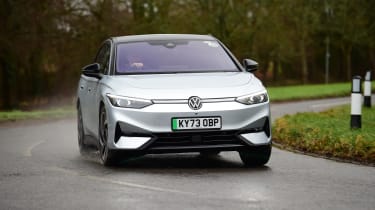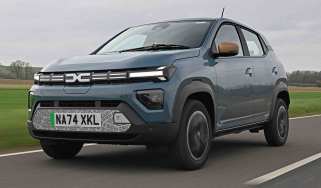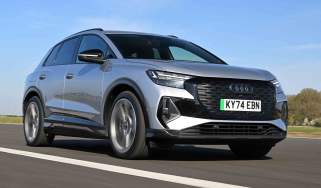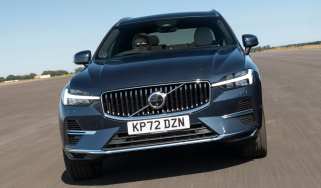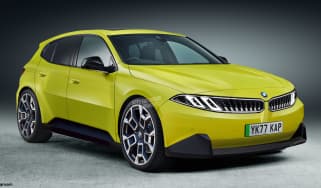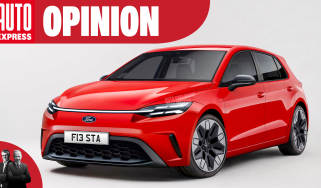Volkswagen ID.7 review
The Volkswagen ID.7 is the brand’s best EV to date, offering plenty of range and tonnes of practicality

Is the Volkswagen ID.7 a good car?
With the march towards electrification gathering pace and the arrival of ever more efficient EVs that can go further on a charge, the Volkswagen ID.7 needs to be good. And thankfully, the German brand has worked hard to learn from experience with its early EVs.
In terms of its cabin, technology and general driving experience, the ID.7 easily justifies its price tag. The VW has every right to be considered in the same sentence as cars like the Tesla Model 3 – as well as bigger rivals costing considerably more.
| Key specs | |
| Fuel type | Electric |
| Body style | Five-door hatchback, five-door estate |
| Powertrain | 77kWh (useable) battery, 1x e-motor (Pro Match) rear-wheel drive 86kWh (useable) battery, 1x e-motor (Pro S Match) rear-wheel drive 86kWh (useable) battery, 2x e-motor (GTX 4Motion) four-wheel drive |
| Safety | 5-Star EuroNCAP (2023) |
| Warranty | 3yrs/60,000 miles |
How much does the Volkswagen ID.7 cost?
Given that the Volkswagen ID.7 is one of the brand’s biggest electric cars to date (it’s a full 249mm longer than the VW ID.Buzz, for example), it perhaps isn’t surprising to find it starts at nearly £51,500. Those looking to go further on a charge will need to stump up around £55,500 for the larger battery pack in the Pro S variant, while the four-wheel-drive GTX comes in at around £62,000.
As already mentioned, the ID.7 isn’t the only Volkswagen EV, and even if the reaction to the company’s early efforts was a little lukewarm, you could hardly accuse the brand of resting on its laurels. Following limp launches for the VW ID.3, VW ID.4 and VW ID.5, the bold-looking ID.Buzz won us over with its charming personality and practical interior.
But the ID.7, which acts as flagship for VW’s electric-car range, is its most impressive EV to date. It’s available as a saloon-cum-hatchback, or the more versatile Tourer estate. The hatchback is the one we’ll be focusing on in this review, and despite the circa-£50k price tag, it’s more closely aligned with the Tesla Model S in terms of size than a Tesla Model 3.
Whereas it merely matches the smaller Tesla from a handling perspective, it punts it into next week when it comes to practicality. However, while the Volkswagen will be better for a family vacation, it still sits behind the Model 3 when it comes to electric efficiency and charging speeds. That’s a shame, considering the ID.7 is more expensive.
All rear-wheel-drive ID.7 models come with a single 282bhp electric motor, but there’s a choice of battery size. The entry-level Pro has a 77kWh battery pack, which is the same set-up you’ll find in the ID.4 and ID.5, but the slippery shape of the ID.7 means it offers better efficiency and range (up to 383 miles) than its bulkier SUV-style siblings. If that isn’t enough for you, there’s an even larger 86kWh battery pack in the Pro S model, offering up to 437 miles of range, plus a faster charging speed to keep the rapid-charge time below 30 minutes.
Finally, the high-performance GTX model offers swifter acceleration thanks to a twin-motor four-wheel drive system delivering 335bhp. It comes exclusively with the larger of the two battery sizes to give it a decent range despite the additional weight of its four-wheel drive system.
Every ID.7 comes in well equipped Match trim, featuring matrix-LED lights and 19-inch wheels, plus three-zone climate control, wireless Apple CarPlay and Android Auto, a 15-inch Discover Pro infotainment system, and an augmented-reality head-up display. Frustratingly, a range-preserving heat pump is a £1,050 option, despite it being standard fit on both the cheaper BYD Seal and Model 3.
Four-wheel drive GTX models feature unique 20-inch alloy wheels, an upgraded Harman Kardon sound system, ventilated front seats, adaptive suspension, and sportier exterior styling.
Electric motors, performance & drive
In short, the Volkswagen ID.7 does a good job of hiding its size, but it just lacks the ultimate agility of a BMW i4 or Model 3 point-to-point, tending to lean over more in bends and feeling lazier to respond to quick changes of direction. It also isn’t as quick as its Model 3 rival in standard form, although anyone coming to the ID.7 from a traditional petrol or diesel car is unlikely to be disappointed. Refinement and ride comfort are ID.7 strong points, which go hand in hand with it being a long-distance EV.
| Model | Power | 0-62mph | Top speed |
| ID.7 Pro Match | 282 bhp | 6.5 seconds | 112 mph |
| ID.7 Pro S Match | 282 bhp | 6.6 seconds | 112 mph |
| ID.7 4Motion GTX | 355bhp | 5.5 seconds | 112 mph |
What is the Volkswagen ID.7 like to drive?
In town
At nearly five metres long, the ID.7 isn’t going to be the easiest car to slot into a parking space, but the 360-degree camera system and parking sensors front and rear give you some assistance.
All the controls are smooth, although we would like there to be more adjustment in the regenerative braking system. It works automatically by increasing the regen as you approach junctions, using information from either the navigation system or the camera and radar systems spotting slower-moving traffic ahead. Alternatively, it can be on all the time when you lift off the accelerator if you’ve engaged the ‘B’ mode on the gear selector. The latter isn’t quite strong enough to offer the one-pedal driving mode of cars like the Model 3 or the e-Pedal system used in the Nissan Ariya, though.
Other than that, the ride is commendably supple at low speeds despite the big 19-inch alloy wheels that come as standard, especially when you have the optional adaptive suspension that’s available in conjunction with the Exterior Pack Plus. This allows you to soften the suspension to deal with the harshest shocks from potholes and speed bumps.
On A- and B-roads
We also found the optional adaptive suspension provides excellent damping at higher speeds. Even when paired with the largest 20-inch wheels and the suspension in its firmest setting, the ID.7 still manages to deal with bigger bumps well and feels resolutely tied down at all times, if a touch fidgety over rougher road surfaces. In its softest setting, that slight fidget disappears, and the ID.7 feels positively serene, floating over uneven surfaces that rivals like the Hyundai Ioniq 6 and Polestar 2 would jiggle over. As you’d expect, this makes the ID.7 an incredibly refined long-distance cruiser, yet that sense of being isolated from the outside world doesn’t come at the expense of body control, and the ID.7 has an inherently wide track that aids stability.
Even in the pouring rain and in single-motor guise, the ID.7 provides all the traction you need. For those after something even more capable in slippery conditions, a dual-motor GTX model with the added traction of four-wheel drive is also available. This version doesn’t feel any sportier than the standard ID.7, but you can sense the front motor kick in to drag you out of trouble should the back of the car start to slip a little in a tight bend.
There’s no getting around the fact that the ID.7 is a very heavy car, though. All versions weigh over two tonnes, and even putting the car in its firmest driving mode cannot disguise the reality that the ID.7 is a big car clearly set up for comfort rather than driving thrills. It would be good if there were a little more bite to the brake pedal, because it feels a bit soft and doesn’t give you the same confidence when driving quickly as you get from the BMW i4 or Tesla Model 3
On the motorway
The Volkswagen ID.7 is definitely the most grown-up of Volkswagen’s electric-car range – and this feeling continues at higher speeds. Laminated side windows (the optional Exterior Pack Plus adds laminated side glass for the rear passenger doors) make this an almost eerily quiet car at low speeds, but even on the motorway, the ID.7 remains impressively refined, even when fitted with the largest 20-inch wheels.
All versions come with an adaptive cruise control system with lane assist to offer a semi-autonomous driving experience. When switched on, it helps with steering and braking to take some of the strain out of long drives, and manages to keep you centred in your lane, avoiding the sensation that you’re being bounced between the markings.
Engines, 0-60 acceleration and top speed
Even with a not inconsiderable 282bhp on tap in the ID.7, its 2,100kg weight (the four-wheel-drive GTX is 2,253kg) means that performance is some way off the class best. Don’t get us wrong, a 0-62mph time of 6.5 seconds (6.6 seconds for the heavier Pro S version) isn’t anything to be sniffed at, because it compares well with a traditional petrol or diesel car. But you’ll need the costliest GTX version with 335bhp in order to beat the acceleration times of even the entry-level Tesla Model 3 RWD or single-motor Polestar 2.
The 5.4-second 0-62mph sprint of the GTX is still more than swift enough in the real world, but it isn’t going to eclipse the sub-3.0-second 0-62mph time of the cheaper Tesla Model 3 Performance. All versions of ID.7 have a top speed of 112mph, which is more than enough in the UK, and would only be important in countries with an unlimited top speed on their motorways.
Range, charging & running costs
The entry-level Volkswagen Pro can do up to 383 miles on a charge, while a larger battery pack in the Pro S version increases the driving range up to 437 miles.
However, efficiency is becoming ever more important. During a group test with its five main rivals, we found the VW ID.7 was the third most efficient, but the 3.4mi/kWh we measured still only equates to an overall real-world range of 262 miles with the 77kWh battery pack. We got 3.3mi/kWh from a Tourer with the bigger 86kWh Pro S battery pack in mild temperatures on a mixture of fast A and B-roads, plus some motorway driving, which works out to around 284 miles of range. The latter test car didn’t have a heat pump fitted, so the range and efficiency might have been better if one had been fitted.
It is a shame that VW still charges extra for a heat pump, which is standard on many of the ID.7’s rivals, and helps to improve the range in colder weather by giving you a more efficient way of heating the interior without having to use as much electricity from the battery.
Rapid charging is possible at up to 170kW for the 77kWh Pro model – matching the base Tesla Model 3. The 86kWh Pro S ups the charging speed to 200kW, but that falls short of the Tesla Model 3 Long Range, which is capable of 250kW top-ups. Either way, VW’s charging curve is sufficiently flat that the maker claims a 10-80 per cent refill in either version is possible in under 30 minutes – roughly the same as the range-topping Tesla.
What’s also like the Tesla is that you’re able to precondition the battery ahead of visiting a rapid charger, either through route planning in the sat-nav system, or manually in the battery sub-menu. This is helpful because the car doesn’t have to waste time preparing the battery before ramping up to accept the maximum charging speed when you plug in, which will save time if you have to make multiple charging stops during a journey.
Those who have access to a 7.4kW wallbox charger at home should be able to refill a flat battery (a worst-case scenario) in a little over 12 hours with the Pro version, and just under 14 hours with the Pro S and GTX models.
| Model | Battery size | Range | Insurance group |
| ID.7 Pro Match | 77kWh (useable) | 383 miles | 38E |
| ID.7 Pro S Match | 86kWh (useable) | 437 miles | 39E |
| ID.7 4Motion GTX | 86kWh (useable) | 366 miles | 41E |
Tax
Electric cars like the ID.7 will cost company car drivers less in terms of lower Benefit-in-Kind (BiK) tax rates compared with traditional petrol, diesel, or even hybrid-powered cars because of zero-tailpipe emissions. EVs also benefit from not having to pay road tax or the London congestion charge, at least until 2025.
Insurance groups
Insurance for an electric car isn’t going to be as inexpensive as an equivalent petrol or diesel car, but the group 38 rating for the Volkswagen ID.7 Pro and 39 for the Pro S. That’s a little higher than the Tesla Model 3 RWD, which starts in group 36, but the ID.7 is likely to be more affordable to insure the BYD Seal, which starts in group 48.
The high-performance ID.7 GTX will be the most expensive model in the range to insure because it starts in group 41.
Depreciation
The VW badge is a known quantity, which helps with regard to desirability and the predicted resale values of the ID.7 compared with its rivals. According to our expert data, the ID.7 is likely to retain between 51 and 54 per cent of its resale value over three years or 36,000 miles, which is much better than the 38 to 40 per cent a Polestar 2 is expected to retain, or the 44 to 48 per cent the Hyundai Ioniq 6 is likely to hold onto over the same period.
To get an accurate valuation for a specific model, check out our free car valuation tool...
Interior, design & technology
The Volkswagen ID.7 differs from the Tesla Model 3 and Hyundai Ioniq 6, in that while it resembles a similar saloon design, the ID.7 is a hatchback, much like the BMW i4.
That more practical bodystyle doesn’t hurt its aerodynamic efficiency, though, because the ID.7 has an impressively low drag coefficient of 0.25, which is very handy for giving it additional electric range over bulkier electric SUVs.
You have a choice of six colours with the ID.7, and four of those – Stonewashed Blue, Scale Silver, Glacier White and Aquamarine Blue – can be specified with a contrasting black roof. None of them are quite as bright as the colours available on the BMW i4 or Tesla Model 3, but at least you won’t be hit with a hefty bill (between £1,300 - £2,000 in the case of the Model 3) if you want metallic paint on your ID.7.
What is the Volkswagen ID.7 like inside?
It’s all quite smart inside the ID.7, but don’t expect any bright colour choices because the palette is a sombre one. If you want something beyond black, grey and silver, you’ll have to make use of the 30-colour ambient interior lighting system.
The main controls are a little confusing at first – the wipers are embedded on a stalk to the left of the steering wheel, rather than the right, for example – but at least they’re not buried within the touchscreen, and you still get indicators on a stalk, unlike on the Tesla.
One thing that is now lost within the screen is the adjustment of the central air-vent controls. As has been the case for decades now, you had simple manual controls to direct the airflow, but VW has followed Tesla's example of automating this adjustment and sticking it within the screen. In our view, it makes what was once an easy adjustment needlessly complicated.
What is the interior quality like?
Let’s first address the elephant(s) in the room. Volkswagen’s early ID cars came under heavy criticism for their lacklustre interior quality, plus fundamental failings in their technology and infotainment. With the ID.7, the maker is looking to right those wrongs.
Indeed, from the driver’s seat, all appears well. The general cabin ambience has been lifted to a level that easily competes with cars in this class; there are soft-touch materials on the doors and dash, and the seats offer plenty of support.
Sat-nav, stereo and infotainment
The Volkswagen ID.7’s big, bright, 15-inch central display instantly feels more responsive than in the maker’s previous electric offerings. The menu layout still has some controls buried deep within sub-menus, but at least the large screen in the ID.7 allows some frequently used functions to be on permanent display, such as the climate controls at the bottom of the screen.
Volkswagen has deemed it appropriate to backlight the adjustment sliders for the climate temperature and audio volume settings found at the base of the screen, so you can now find them at night. They’re still touch-sensitive, which means they’re not as easy to adjust on the move as the physical climate controls of the Hyundai Ioniq 6. Overall, we still prefer the BMW i4’s clickwheel design because it makes controlling an infotainment system much easier while on the move.
Wireless smartphone connectivity and a wireless phone charging pad are standard. All ID.7s come with a nine-speaker audio system with DAB radio, but you’ll need to pay for the pricey £2,000 Interior Pack to get the upgraded 12-speaker, 700-watt Harman Kardon sound system.
Boot space, comfort & practicality
The Volkswagen ID.7’s large hatchback body gives it a practical advantage over rivals in this large EV class that stick with the traditional saloon format. All ID.7 models come with front and rear parking sensors, plus a 360-degree camera system to improve visibility when parking – although the latter has a lower-resolution feed than we’d expect of a car costing over £50,000. Standard LED-matrix headlights provide very good visibility at night while also adjusting the beam pattern to avoid dazzling oncoming traffic.
| Dimensions | |
| Length | 4,961mm |
| Width | 1,862mm (2,141mm including the mirrors) |
| Height | 1,536mm |
| Number of seats | 5 |
| Boot space | 532-1,586 litres |
Dimensions and size
The car’s length alone means the Volkswagen is a much more spacious car than a BYD Seal or Tesla Model 3. The ID.7 is 241mm longer than the Model 3, and 161mm longer than a Seal, so factor that into your calculations about where you’ll park it. The ID.7 isn’t as wide as the Seal, but it is taller than both of its rivals.
Go for the ID.7 Tourer, and both the length and width remain the same as the hatch, but the height goes up by 15mm to 1,551mm.
How practical is the Volkswagen ID.7?
Seats & space in the front
Adults who are six feet tall will have no trouble getting comfortable in the front of the ID.7. All versions come with electrically adjustable front seats with memory settings on the driver’s seat, and there’s electric lumbar support for additional comfort. There’s also plenty of head, leg, and shoulder room to stretch out in.
The centre console is tall and there’s plenty of storage space under the centre armrest, plus a pair of cup-holders ahead of it under a roller cover. The front door bins are generously sized and are flocked to prevent items from rattling in them as you drive along.
Seats & space in the back
The vast length and wheelbase of the ID.7 are really felt in the back, where kneeroom is limo-like, and (according to our tape measure) headroom is far more generous than in the likes of the BMW i4 or Tesla Model 3. The well equipped Match trim comes with electric adjustment on the front seats, including electric lumbar adjustment, memory settings, and seat-depth adjustment, so there’s plenty of scope to find a comfortable driving position.
Families with young children who need child seats will be pleased to find Isofix child seat mounting points conveniently hidden behind some removable plastic covers on the outer positions of the rear seats. There are also Isofix mounts on the front passenger seat to provide some flexibility in where you can put child seats.
Boot space
Put simply, the Volkswagen ID.7 has a huge 532-litre boot that dwarfs the Model 3’s 425-litre luggage area. Folding the rear seats down in the ID.7 increases capacity up to 1,586 litres, with the 60:40-split bench lying almost flat, making an IKEA run that little bit easier. All models get a variable-height boot floor to remove the annoying load lip and provide a space beneath the floor where you can store the charging cables or even the parcel shelf if you need to remove it.
There is the Volkswagen ID.7 Tourer estate if you need even more boot space, with 605 litres available with the seats up, and 1,948 litres with the seats down – the latter figure is even greater than a similarly configured Skoda Superb Estate or Mercedes E-Class Estate.
Despite the saloon shape being less practical than a traditional estate, the ID.7 still has a roof-hinged hatch, which works wonders for accessibility when loading bigger items. The boot opening in the ID.7 is much bigger than the narrow, letterbox-like opening you’ll find in both the BYD Seal and Tesla Model 3.
Towing
With the introduction of the Pro S version, the Volkswagen ID.7 can be ordered with a tow bar (for just over £1,000) to complement this version's 1,000kg braked towing capacity. Opting for the four-wheel-drive GTX model not only helps with traction on wet grass, but increases the towing capability to 1,200kg.
Neither figure is a huge amount for car of this size and weight. If you want more capacity and still need some electrified driving, the plug-in eHybrid versions of Volkswagen Tiguan and Volkswagen Passat can both handle a 1,800 kg caravan or trailer.
Reliability & safety
The Volkswagen ID.7 is too new to have appeared in our most recent Driver Power owner satisfaction survey. However, the Volkswagen brand has its work cut out because it finished even lower than its 2023 manufacture score (27th out of 32), finishing in a disappointing 29th position out of 32 in our 2024 survey. That narrowly put it ahead of Ford (30th), but behind Skoda (23rd), Hyundai (17th), and BMW (14th).
At least the ID.7 should be a very safe place to put you and your loved ones if you do end up in a collision. It received the maximum five-star rating from safety experts Euro NCAP in 2023, with higher scores in all areas than the BYD Seal.
As you’d expect with such a high score, the ID.7 comes loaded with safety features and assistance technology. There’s autonomous emergency braking (AEB) to help mitigate or prevent low-speed collisions with other vehicles, cyclists and pedestrians. You also get adaptive cruise control to keep you a safe distance from the vehicle in front, as well as lane-keep assistance to help maintain your positioning within the lane.
Blind-spot monitoring alerts you to vehicles approaching alongside you when you change lanes. It also works while you're parked at the side of the road to prevent you from opening a car door and stepping out into the path of a vehicle approaching you. The ID.7 comes with a rear cross-traffic alert system to let you know of vehicles crossing your path as you go to reverse onto a busy main road.
| Key standard safety features | Euro NCAP safety ratings |
|
Warranty
VW’s standard three-year/60,000-mile manufacturer warranty might reassure you, although it is shorter than Hyundai's five-year/100,000-mile warranty and Kia's seven-year/100,000-mile warranty. Even the Volkswagen Group’s own Cupra brand now offers a longer five-year/90,000-mile warranty, so we hope that VW looks to extend the length of cover it offers.
Servicing
Anyone who covers a lot of miles in their car will be pleased to discover that not only are the service intervals for the ID.7 every two years, but you can also cover an unlimited number of miles during that time. You can set up a service plan for your ID.7 at the time of purchase for £15.50 per month over 24 months, or as a lump sum for £372.
Volkswagen ID.7 alternatives
As we already mentioned, people considering the Volkswagen ID.7 are likely to be comparing it with the Tesla Model 3, and if ease of charging away from home and overall efficiency are your major concerns, then the ID.7, unfortunately, comes up a little short. That’s not to say it can’t handle a long trip, because every ID.7 uses a sizeable battery pack (77kWh or 86kWh) that can be recharged at a relatively fast speed. But the Model 3 is just that little bit further ahead in terms of getting the most from your volts according to our real-world testing, and Telsa’s infrastructure is second to none.
However, the ID.7 is leagues ahead of the Model 3 (and many of its other rivals) when it comes to practicality. The VW is significantly bigger, meaning it can cope with family life much better, especially if you have older (and taller) children. Comfort is also a major plus point, particularly with the adaptive suspension. True, the ID.7 can’t out-handle a Model 3 or BMW i4, but to buyers who just want a car that's comfortable and refined, that won’t matter very much.
Frequently Asked Questions
Volkswagen states that its ID line-up of electric cars only requires servicing every two years, with no specified mileage limits.
